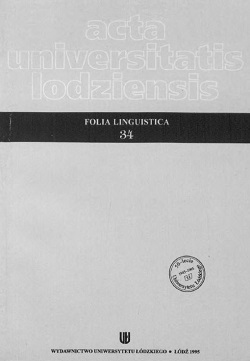Constructions with Preposition dla in the Polish Language
DOI:
https://doi.org/10.18778/0208-6077.34.05Abstract
The aim of the present article is to analyse different semantic-syntactic functions of the preposition dla from the oldest times until the present day and the changes in its use and application.
In the Old Polish the preposition dla functioned as adverbial of reason and of purpose. In the 16th century it occasionally signified the relations of use, harm, and appropriation (zrobić kolację dla dzieci - to prepare supper for the children). Since the 18th century it was extensively used in this sense and supplanted the traditional Dativ in the verbal, adjectival, and nominal relations. Only in a single case was its occurence limited - in the 20th century it ceased to signify causal relations (nie zjeżdżaj z gościńca dla złej drogi - do not leave the highway for bad track, with „for” meaning „because of" in this case).
Downloads
Downloads
Published
How to Cite
Issue
Section
License

This work is licensed under a Creative Commons Attribution-NonCommercial-NoDerivatives 4.0 International License.










